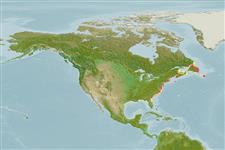Common names from other countries
Environment: milieu / climate zone / depth range / distribution range
Ecologia
; intervalo de profundidade 11 - 16 m (Ref. 1239). Subtropical
Western Atlantic: USA and Canada. Tropical to polar climates of northern hemisphere.
Length at first maturity / Tamanho / Peso / Idade
Maturity: Lm ? range ? - ? cm Max length : 0.2 cm TL macho/indeterminado; (Ref. 1239); common length : 0.1 cm TL macho/indeterminado; (Ref. 1239)
Found in the littoral zone. Active hunter (Ref. 111265).
Life cycle and mating behavior
Maturidade | Reprodução | Desova | Ovos | Fecundidade | Larvas
Members of the class Aplacophora are mostly hermaphroditic. Life cycle: Eggs hatch into lecitotrophic larvae which later develop into adults.
Morse, M.P. and J.L. Norenburg. 1992. (Ref. 1239)
Categoria na Lista Vermelha da IUCN (Ref. 130435)
Categoria CITES (Ref. 108899)
Not Evaluated
Not Evaluated
Ameaça para o homem
Harmless
Utilização humana
| FishSource |
Ferramentas
Mais informação
Idade/Tamanho
Crescimento
Comprimento-peso
Comprimento-comprimento
Morfologia
Larvas
Abundância
Fontes da internet
Estimates based on models
Preferred temperature
(Ref.
115969): 3.1 - 23.7, mean 7.2 (based on 168 cells).
Vulnerabilidade
Low vulnerability (10 of 100).
Categoria de preço
Unknown.
